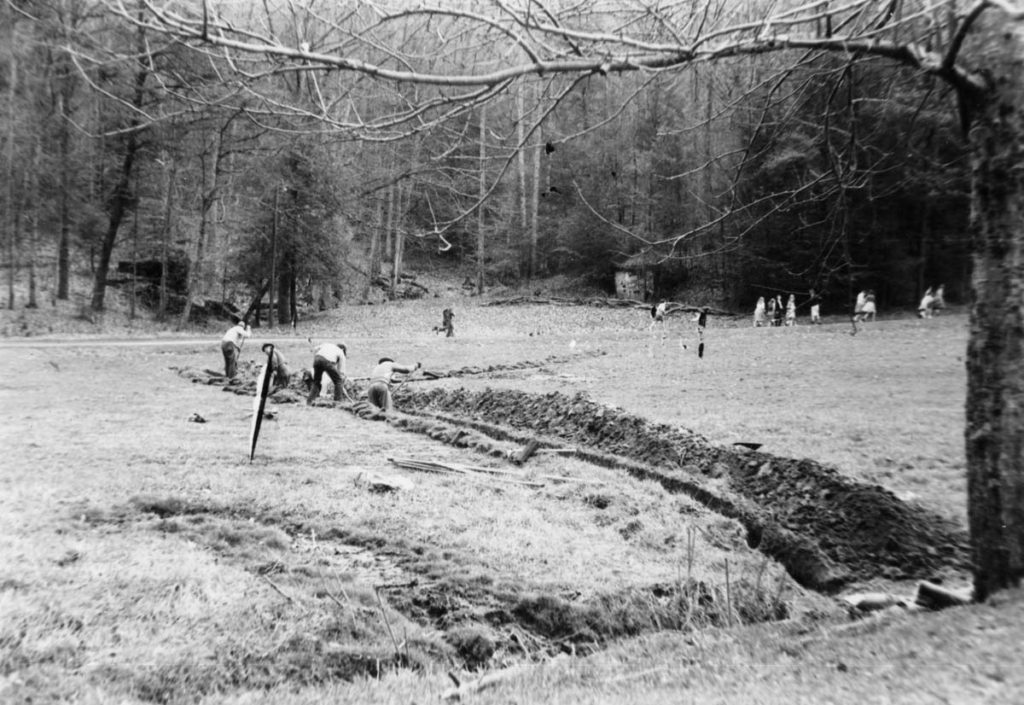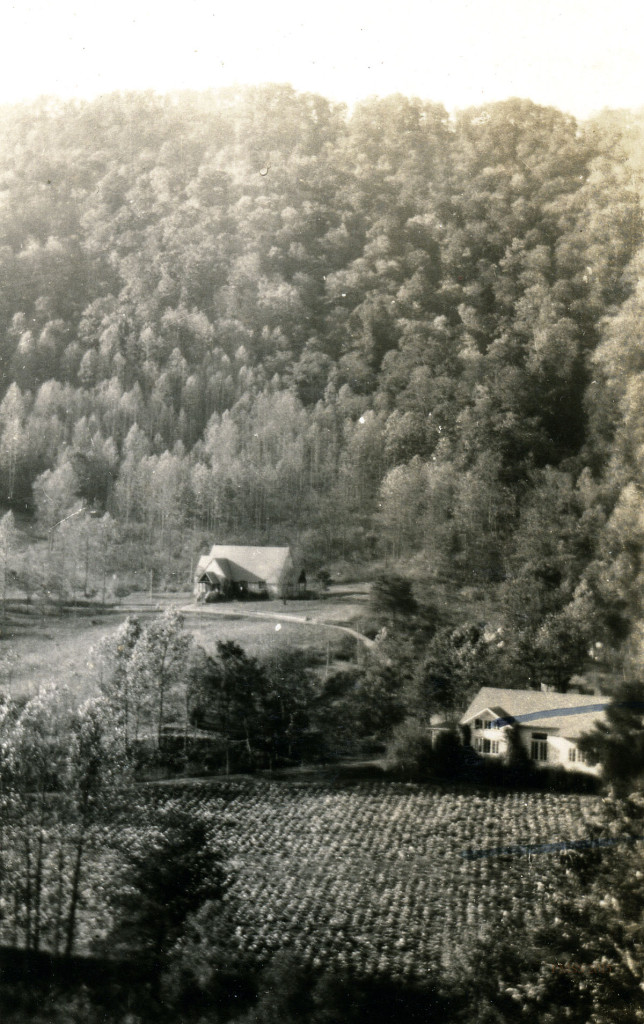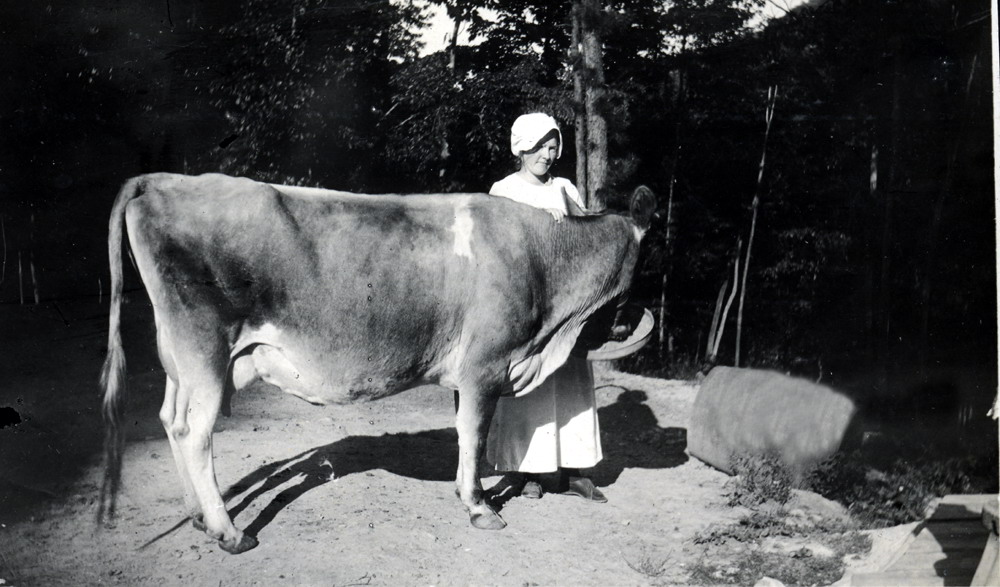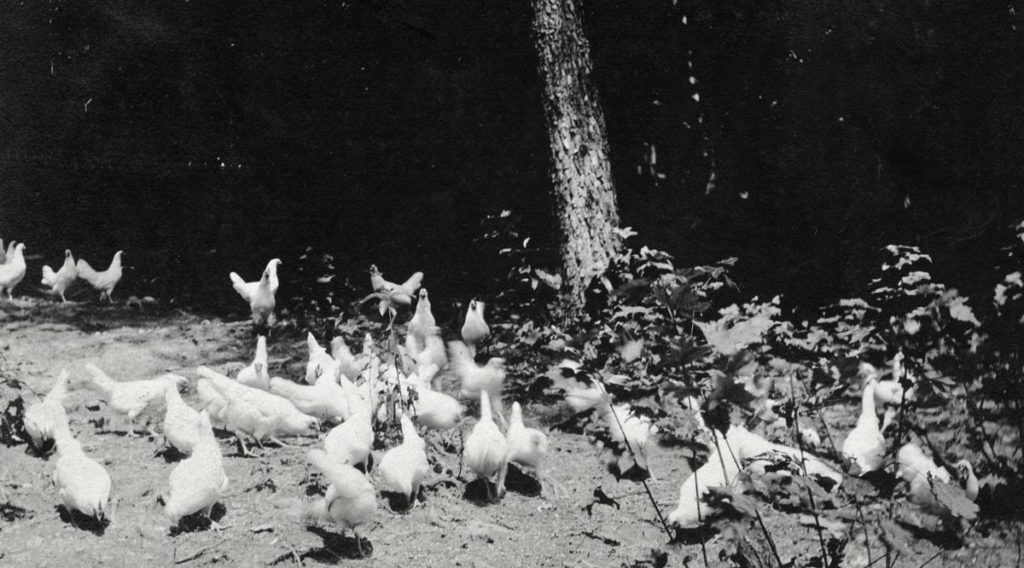Pine Mountain Settlement School
Series 09: Biography – Staff/Personnel
Series 03: Histories
Series 10: Built Environment
Series 11: Farm
WELLS RECORD 08 PMSS Farm Dairy Poultry
WELLS RECORD 08 PMSS FARM DAIRY POULTRY is a history written by Evelyn K. Wells of activity on the Farm, the Dairy and Poultry at Pine Mountain Settlement School from 1913 until 1928.
TAGS: Wells Record 08 PMSS Farm Dairy Poultry ; Evelyn K. Wells ; histories ; Pine Mountain Settlement School ; farms ; farming ; dairy ; poultry ; Mr. Baugh ; Mr. Horace McSwain ; Mr. William Browning ; Kitchens ; model farms ; chickens ; cows ; Ayrshires ; Holsteins ; Jerseys ; Guernseys ; “Mountain Scrub’ cows ; canning ; food preparation ; crop rotation ; Elizabeth Hench ; Joy Stock Club ; milking ; Philip Roettinger ; Board of Trustees ; Miss Fawcett ; White Leghorns ; Rhode Island Reds ; terracing ; soil enrichment ; soil sampling ; Soil analysis ;
The farm, under the continuous supervision of Miss Pettit [Katherine Pettit] has been developed by Mr. Baugh (1914), Mr. [Horace] McSwain (1921, full charge 1923). Mr. Zande [Luigi Zande] (1916), Mr. [William] Browning (Assistant to Mr. Zande 1921, full charge 1923.)
After some experimenting with the raising of corn, that was found to be too expensive a crop for us and the chief effort has gone into developing, by ditching and draining and building up a sour, heavy soil, with cover crop a garden which little by little has spread over our bottom land until in June 1928 its produce was worth some $3,200. Our garden land had a sorry reputation among local farmers when the school began but by dint of thousands of feet of ditching and draining and a long rotation of crops it has been built up from an unproductive swamp and the kitchen is extremely dependent upon it.

Ditch digging. VII 63 Life Work Maintenance, Farm, Grounds. [VII_63_life_work_001.jpg]
During Mr. Zande’s regime the work of ditching and replacing old ditches went on, the creeks were straightened to give a handful more of tillable land here and there, the boulders that one met all through the garden were blasted out, more land was cleared, and the timber used in construction, instead of being burned according to the usage of the country; and at the end of that time there were about 75 acres in farm and garden.
During the period that Mr. [William] Browning has had charge, the garden acreage has practically doubled, and the work of early years has borne fruit in Mr. Browning’s wonderful garden crops. The policy of sowing cover and legume crops and turning them under as an equivalent for manure has continued.
The increase in garden truck is shown by the fact that in 1923 we had 48 bushels of tomatoes from the garden, and in 1928 118 bushels. As against the 400 cabbages we raised in 1923, we think of the 9,000 in 1927, of which those sold in the neighborhood hand to the lumber camps alone after the family wants were supplied were worth $125.00.

“Old Laurel House.’ “Cabbages” [kingman_048b.jpg]
When one looks at our herd of fifteen milking cows, our Ayrshire bull in his pen, the calves and heifers coming along, the barn with its concrete stalls and improved stanchions, the carefully screened milk-room with its accurate records for each cow, and the simple but intelligent arrangements for the care of feed; and when one hears that we are now getting a little over a quart of milk a day per person even in the winter, it is hard to remember the long road that has been travelled since the early days. In spite of the lack of proper pasture and the expense of hauling carloads of feed sixteen and eighteen miles over rough mountain roads from the railroad, the school has held to the dream of one day being able to give the children all the milk they ought to have.

[II_7_barn_273.jpg]

[hench_0006.jpg]
From the detailed figures on the production of milk, one compares October 1915 with its 540 quarts, with October 1919 with 1,400 quarts, and October 1928 with 2,000 quarts.

Poultry. White leghorns. Katherine Pettit Album I. [pettit_33_003.jpg]
In this department, too, we have had to work through a period of trying out delicate stock, the whole flock being White Leghorns when we first filled our new chicken houses in 1917 from eggs hatched in Miss Fawcett’s incubators. We now know that Rhode Island Reds are far more practical for us, and after years of experimenting have settled down to a very healthy and successful, if somewhat expensive, flock of hens. https://pinemountainsettlement.net/?p=6106
SEE ALSO:
DANCING IN THE CABBAGE PATCH VI – POULTRY
DANCING IN THE CABBAGE PATCH IV – FARMING THE LAND – THE EARLY YEARS 1913-1930
EVELYN K. WELLS GUIDE TO ADMINISTRATIVE CORRESPONDENCE
EVELYN K. WELLS, GUIDE to EXCERPTS FROM LETTERS HOME 1915-1923
EVELYN K. WELLS 1915 EXCERPTS FROM LETTERS HOME
EVELYN K. WELLS 1915 EXCERPTS FROM LETTERS HOME – Horseback to Hindman
EVELYN K. WELLS 1916 EXCERPTS FROM LETTERS HOME
EVELYN K. WELLS 1917 EXCERPTS FROM LETTERS HOME
EVELYN K. WELLS 1918 EXCERPTS FROM LETTERS HOME
EVELYN K. WELLS 1919 EXCERPTS FROM LETTERS HOME
RECORD OF PINE MOUNTAIN SETTLEMENT SCHOOL 1913-1928 [INDEX] (Early in-depth history of Pine Mountain Settlement School)
2. Introductory
3. Year by Year [Construction, Workers, Gifts, Children, Events, etc.]
10. Academic
11. Health
12. Extension Work
15. Athletics
16. Dramatics
17. Some Contributions to the Outside World
18. Religious Life
19. The Road
22. List of Workers
[22 sections of Pine Mountain Settlement School History gathered by Evelyn K. Wells from 1913 to 1928]
EVELYN K. WELLS PUBLICATIONS
Wells, Evelyn K. The Ballad Tree: A Study of British and American Ballads, Their Folklore, Verse and Music, Together with Sixty Traditional Ballads and Their Tunes. New York: Ronald Press, 1950. Print.
EVELYN K. WELLS “A Little True Blue American,” Over Sea and Land: Our Southern Mountains, November 1920, p. 140.
EVELYN K. WELLS TALKS
EVELYN K. WELLS PMSS Harvard University talk, on Folk Music. July 21, 1955

